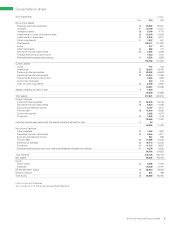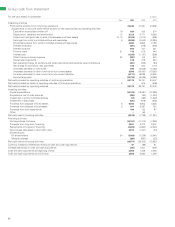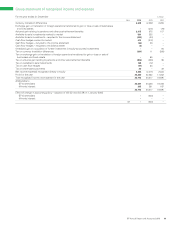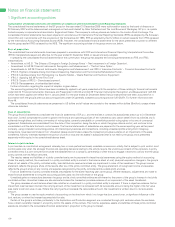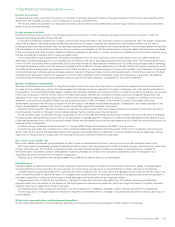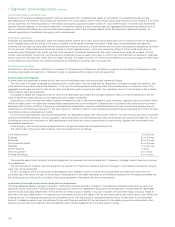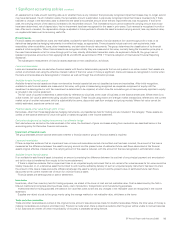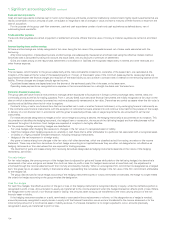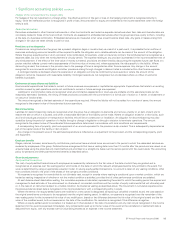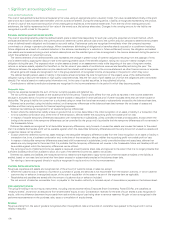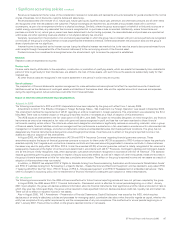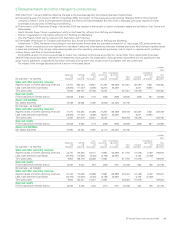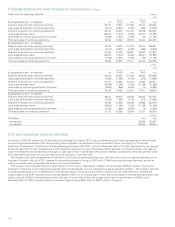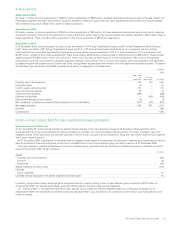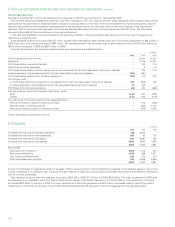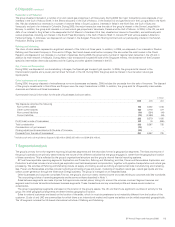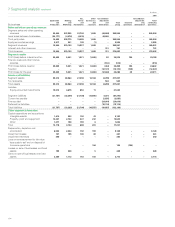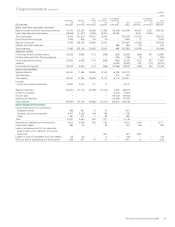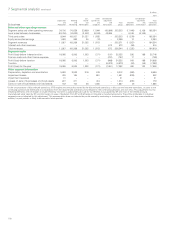BP 2006 Annual Report Download - page 109
Download and view the complete annual report
Please find page 109 of the 2006 BP annual report below. You can navigate through the pages in the report by either clicking on the pages listed below, or by using the keyword search tool below to find specific information within the annual report.BP Annual Report and Accounts 2006 107
1 Significant accounting policies continued
Revenue is measured at the fair value of the consideration received or receivable and represents amounts receivable for goods provided in the normal
course of business, net of discounts, customs duties and sales taxes.
Revenues associated with the sale of oil, natural gas, natural gas liquids, liquefied natural gas, petroleum and chemicals products and all other items
are recognized when the title passes to the customer. Physical exchanges are reported net, as are sales and purchases made with a common
counterparty, as part of an arrangement similar to a physical exchange. Similarly, where the group acts as agent on behalf of a third party to procure or
market energy commodities, any associated fee income is recognized but no purchase or sale is recorded. Additionally, where forward sale and
purchase contracts for oil, natural gas or power have been determined to be for trading purposes, the associated sales and purchases are reported net
within sales and other operating revenues whether or not physical delivery has occurred.
Generally, revenues from the production of oil and natural gas properties in which the group has an interest with joint venture partners are recognized
on the basis of the group’s working interest in those properties (the entitlement method). Differences between the production sold and the group’s
share of production are not significant.
Interest income is recognized as the interest accrues (using the effective interest rate method that is the rate that exactly discounts estimated future
cash receipts through the expected life of the financial instrument) to the net carrying amount of the financial asset.
Dividend income from investments is recognized when the shareholders’ right to receive the payment is established.
Research
Research costs are expensed as incurred.
Finance costs
Finance costs directly attributable to the acquisition, construction or production of qualifying assets, which are assets that necessarily take a substantial
period of time to get ready for their intended use, are added to the cost of those assets, until such time as the assets are substantially ready for their
intended use.
All other finance costs are recognized in the income statement in the period in which they are incurred.
Use of estimates
The preparation of financial statements requires management to make estimates and assumptions that affect the reported amounts of assets and
liabilities as well as the disclosure of contingent assets and liabilities at the balance sheet date and the reported amounts of revenues and expenses
during the reporting period. Actual outcomes could differ from those estimates.
Impact of new International Financial Reporting Standards
Adopted for 2006
The following amendments to IFRS and IFRIC interpretations have been adopted by the group with effect from 1 January 2006.
Amendment to IAS 21 ‘The Effects of Changes in Foreign Exchange Rates’– ‘Net Investment in a Foreign Operation’ was issued in December 2005.
The amendment clarifies the requirements of IAS 21 regarding an entity’s investment in foreign operations. This amendment was adopted by the EU in
May 2006. There was no material impact on the group’s reported income or net assets as a result of adoption of this amendment.
The IASB issued an amendment to the fair value option in IAS 39 in June 2005. The option to irrevocably designate, on initial recognition, any financial
instruments as ones to be measured at fair value with gains and losses recognized in profit and loss has now been restricted to those financial
instruments meeting certain criteria. The criteria are where such designation eliminates or significantly reduces an accounting mismatch, when a group
of financial assets, financial liabilities or both are managed and their performance is evaluated on a fair value basis in accordance with a documented risk
management or investment strategy, and when an instrument contains an embedded derivative that meets particular conditions. The group has not
designated any financial instruments as being at-fair-value-through-profit-and-loss, thus there was no effect on the group’s reported income or net
assets as a result of adoption of this amendment.
In August 2005, the IASB issued amendments to IAS 39 and IFRS 4 ‘Insurance Contracts’ regarding financial guarantee contracts. These
amendments require the issuer of financial guarantee contracts to account for them under IAS 39 as opposed to IFRS 4 unless an issuer has previously
asserted explicitly that it regards such contracts as insurance contracts and has used accounting applicable to insurance contracts. In these instances
the issuer may elect to apply either IAS 39 or IFRS 4. Under the amended IAS 39, a financial guarantee contract is initially recognized at fair value and is
subsequently measured at the higher of (a) the amount determined in accordance with IAS 37 ‘Provisions, Contingent Liabilities and Contingent Assets’
and (b) the amount initially recognized, less, when appropriate, cumulative amortization recognized in accordance with IAS 18 ‘Revenue’. This standard
impacts guarantees given by group companies in respect of equity-accounted entities as well as in respect of other third parties; these are recorded in
the group’s financial statements at initial fair value less cumulative amortization. The effect on the group’s reported income and net assets as a result of
adoption of this amendment was not material.
In addition, in 2006 BP has adopted IFRIC 5 ‘Rights to Interests Arising from Decommissioning, Restoration and Environmental Rehabilitation Funds’
and IFRIC 6 ‘Liabilities Arising from Participating in a Specific Market – Waste Electrical and Electronic Equipment’ and has decided to early adopt IFRIC
7 ‘Applying IAS 29 for the First Time’, IFRIC 8 ‘Scope of IFRS 2 – Share-based payment’ and IFRIC 9 ‘Reassessment of embedded derivatives’. There
were no changes in accounting policy and no restatement of financial information consequent upon adoption of these interpretations.
Not yet adopted
The following pronouncements from the IASB will become effective for future financial reporting periods and have not yet been adopted by the group.
In August 2005, the IASB issued IFRS 7 ‘Financial Instruments – Disclosures’ which is effective for annual periods beginning on or after 1 January
2007. Upon adoption, the group will disclose additional information about its financial instruments, their significance and the nature and extent of risks to
which they give rise. More specifically, the group will be required to make specified minimum disclosures about credit risk, liquidity risk and market risk.
There will be no effect on reported income or net assets.
Also in August 2005, ‘IAS 1 Amendment – Presentation of Financial Statements: Capital Disclosures’ was issued by the IASB, which requires
disclosures of an entity’s objectives, policies and processes for managing capital, quantitative data about what the entity regards as capital, whether the
entity has complied with any capital requirements, and the consequences of any non-compliance. This is effective for annual periods beginning on or
after 1 January 2007. There will be no effect on the group’s reported income or net assets.


